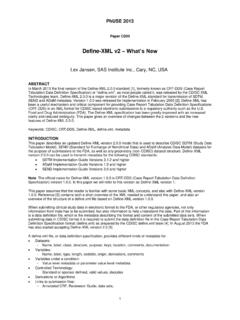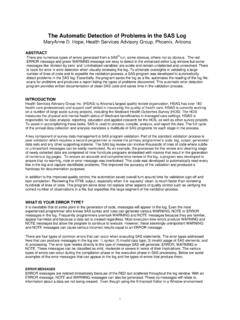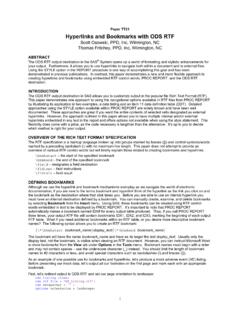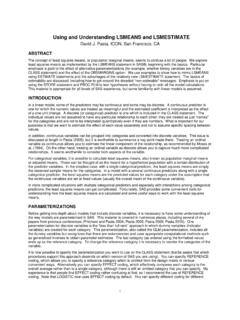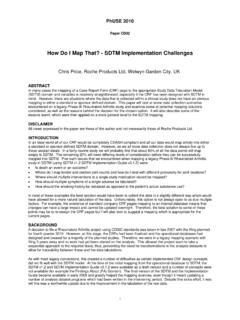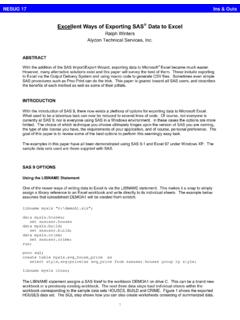Transcription of Illustrative Logistic Regression Examples using PROC ...
1 Paper SP03-2009 Illustrative Logistic Regression Examples using PROC Logistic : New Features in SAS/STAT Robert G. Downer, Grand Valley State University, Allendale, MI Patrick J. Richardson, Van Andel Research Institute, Grand Rapids, MI ABSTRACT PROC Logistic has many useful features for model selection and the understanding of fitted models. The standard generated output will give valuable insight into important information such as significant variables and odds ratio confidence intervals. However, proper utilization of output files, graphical displays and relevant options can further enhance justification of model choice and understanding of model fit.
2 In this fairly general paper, a variety of Logistic Regression topics such as model building, model fitting and the ROC curve will be reviewed. The discussion will introduce the PLOTS= option, as well as the ROCCONTRAST statement as new features which are available in SAS/STAT INTRODUCTION Logistic Regression is a common and popular technique for describing how a binary response variable is associated with a set of explanatory variables. The data can come in one of two forms. In one format, one will have the number of successes out of a sample of independent trials ( a set of binomial counts).
3 In the other and most common, one will have an observation as a 1 or 0 (success or failure) for an individual trial and the row of data corresponds to a single individual/subject. THE MULTIPLE Logistic Regression MODEL We consider the log odds of success versus failure p/(1-p) as a linear function of the predictor variables and the Logistic Regression model for predictors : =++ The multiple Logistic Regression model above is fit through maximum likelihood in PROC Logistic . Standard output from PROC Logistic includes these maximum likelihood parameters 12.
4 K and their standard errors. The subsequent fitted probability p and its standard error can be obtained for each observation. Graphical display of the estimated probability function versus each predictor is a useful display particularly for continuous responses such as dosage or age. Odds ratios are also frequently an emphasis of a study or a study report. Estimated adjusted odds ratios for a given predictor are provided by PROC Logistic as well as approximate confidence intervals. THE receiver operating CHARACTERISTIC CURVE (ROC) The practicality of a Logistic Regression is often evaluated in terms of its predictive ability.
5 In a Logistic Regression , a two by two table classification table can be created for any cut-off value of the fitted probability and hence the sensitivity and specificity are then available for this particular table. The fraction calculated as count of predicted positives divided by the actual total of positives is the sensitivity and the fraction calculated as the count of predicted negatives divided by the total negatives will be the specificity. A series of cut-offs from 0 to 1 and the resulting two by two tables will give plotted pairs (1-specificity, sensitivity).
6 These pairs constitute the receiver operating Characteristic (ROC) curve. Points far above the 45 degree line are desirable and one hopes to have this curve rise as quickly as possible from the origin. The 45 degree line in the unit square would correspond to an area under the curve (AUC) of and represents where the fraction true positives and false negatives are equal and hence the diagnostic would be no better than flipping a coin. The concordance index, denoted c , as provided by PROC Logistic gives the area under the curve (AUC) for a given model.
7 A nonparametric approach to the comparisons of correlated ROC curves was proposed by Delong et al. and is utilized in the new syntax of PROC Logistic . Contrasts are constructed and comparisons are made using the empirical ROC curves of specified models. NEW FEATURES OF PROC Logistic IN SAS/STAT SAS/STAT contains valuable additions to PROC Logistic which enhance the visualization of model fit and comparisons between two or more models. The ROC and ROCCONTRAST statements provide this enhanced functionality. This paper will explore the application of these new statements, review basic model fitting strategies using PROC Logistic and illustrate the utilization of receiver operating characteristic (ROC) curves.
8 The new ODS graphics capabilities of SAS can provide production quality graphics of the estimated fitted probabilities and ROC curves. example DATA SETS The first utilized data set is originally from Gaylor and also shown by Rao. For full citations, see the reference section. In the SAS code to follow, the data set is referred to as toxdat and there are only six observations with three variables. For each toxin dosage, a count is given of the number of test animals with tumors and the total number of animals tested is also provided.
9 The example illustrates Logistic Regression for grouped binomial counts and illustrates the usage of PROC Logistic for a single continuous predictor (dose). The second dataset used is from Pine et al. from an article published in, Archives of Surgery. This particular study looked at the incidence of organ malfunction and death for patients who had intra-abdominal sepsis found during a surgical procedure. Variables collected for analysis included age, as well as the binary variables, malnutrition, alcoholism, shock and bowel infarction, (where 0 indicated that the symptom was absent and 1, that it was present).
10 In the SAS data set referred to as pinedat , the response variable, survival, was coded as 0=Alive and 1=Deceased. In this work, we have used the authors original data and applied PROC Logistic using the ROC and ROCCONTRAST statements to assist in determining the best model fit for the available predictor variables. example 1 (ILLUSTRATING PLOTS = EFFECT, PLOTS = ROC OPTION) With ODS graphics invoked in SAS/STAT , consider the following run of PROC Logistic : proc Logistic data=toxdat plots=EFFECT plots=ROC; model count/n = dose / outroc = rocout; output out=estimated predicted=estprob l=lower95 u=upper95; run; The plots option produces the following graphics.
